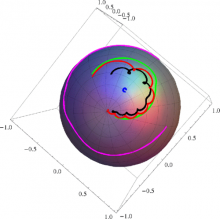
Abstract
We evolve a set of 32 equal-mass black-hole binaries with collinear spins (with intrinsic spin magnitudes |→S1,2/m21,2|=0.8) to study the effects of precession in the highly nonlinear plunge and merger regimes. We compare the direction of the instantaneous radiated angular momentum, ˆδJrad(t), to the directions of the total angular momentum, ^J(t), and the orbital angular momentum, ^L(t). We find that ˆδJrad(t) approximately follows ^L throughout the evolution. During the orbital evolution and merger, we observe that the angle between →L and total spin →S is approximately conserved to within 1°, which allows us to propose and test models for the merger remnant’s mass and spin. For instance, we verify that the hang-up effect is the dominant effect and largely explains the observed total energy and angular momentum radiated by these precessing systems. We also verify that the total angular momentum, which significantly decreases in magnitude during the inspiral, varies in direction by less than ∼5∘. The maximum variation in the direction of →J occurs when the spins are nearly antialigned with the orbital angular momentum. Based on our results, we conjecture that transitional precession, which would lead to large variations in the direction of →J, is not possible for similar-mass binaries and would require a mass ratio m1/m2≲1/4.